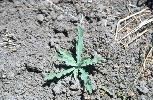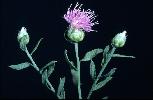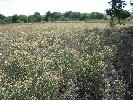Acroptilon repens
Commonly known as Russian knapweedDescription
Russian Knapweed (Acroptilon repens) is a creeping herbaceous perennial weed that is currently invading New Mexico. Within New Mexico it can readily invade pastures, degraded croplands, alfalfa fields, rangeland, roadsides, riparian areas, and irrigation ditches. Russian knapweed shoots emerge early in the spring and form a rosette. By late spring, flowering stems begin to develop with flowers visible by early summer. Flowers senesce by mid summer, but shoots remain green and photosynthetic until the first frost in the
fall.
This plant is originally from southeastern Asia; it is now widespread in northern states including Colorado, Montana and Wyoming. In New Mexico, it was first documented in 1943 in Quay County and to date can be found throughout most
counties. Distribution is extensive in the northern counties of New Mexico where large infestations exist. Small populations exist in central and southern New Mexico and if not managed, Russian knapweed infestations could become common
throughout the entire state. Rapid response and eradication of these small infestations is critical to prevent the spread of this invasive weed.
Identification
Russian knapweed shoots are erect, branched and are typically 1 to 3 feet tall when mature. Leaves on the lower portion of the stem are 2 to 4 inches long and deeply lobed, while upper leaves are smaller and less lobed with smooth margins. Dense grey hairs cover the surface of both shoots and leaves. Flower heads occur on shoot tips, and are urn-shaped, generally 1/4 to 1/2 inch in diameter with smooth papery bracts. Flower color can range from pink to lavender or white. Russian knapweed roots grow vertically and horizontally in the soil and have a brown to black scaly
appearance, especially near the soil surface. These black roots can be used to distinguish Russian knapweed from other closely related highly invasive knapweeds (Whitson
et al 1996).
Reproduction and Spread
Russian knapweed produces 50 to 500 seeds from each shoot, which remain viable in the soil for 2 to 3 years (Ivanova 1966). However, the main method of spread for Russian knapweed is not by seed, but from adventitious buds on a creeping perennial root system. Roots have been observed to grow 6 to 8 feet deep in one season, and a single plant can expand radially up to 14 yards in two seasons (Frazier 1944). As infestations develop, they displace nearly all herbaceous resident vegetation, creating dense stands of Russian knapweed. A major reason for this plant’s competitiveness is believed to be from its ability to release allelopathic chemicals that inhibit growth of other plants (Renney and Dent 1958). These compounds have been found to hamper revegetation of previously infested land even after plants have been removed. Light disturbance of the soil surface has been shown to alleviate this problem (Bottoms & Whitson 1998).
Magagement
Prevention, early detection and eradication are the best management tools for Russian knapweed. Establishment and spread is rapid in abandoned agricultural fields and lots that are left unmanaged. This allows infestations to establish large, dense stands with large stores of carbohydrates in the root system. This stored energy allows plants to tolerate future management methods. In contrast, small establishing infestations require fewer resources to eradicate and associated plants can rapidly recover from management methods, thus eliminating the need to restore the site. The best management plan incorporates multiple strategies including cultural, mechanical and herbicidal methods. A single control strategy, such as mowing or herbicide use, is not sufficient to control old, dense infestations (Beck 2003).
Physical/Mechanical/Cultural
Several nonchemical control methods have been tested, but have shown limited effectiveness. Mowing will suppress shoots, but needs to be continually repeated to have any long-term reduction in Russian knapweed populations (Beck 2003). Foraging animals do not effectively graze Russian knapweed due to the bitter flavor of the forage. In addition, Russian
knapweed forage has been demonstrated to be toxic to horses (Young et al. 1970a, b). Disking or plowing infestations breaks roots into fragments that can survive desiccation and be deposited into uninfested areas, thereby increasing the infestation size.
Biological control
The Russian knapweed gall nematode has been released in New Mexico in the Farmington region. This nematode feeds on leaves, stems and root crowns. As a result of feeding visible galls are formed containing the nematodes (Rees et al. 1996). Unfortunately, releases have not shown any reduction in Russian knapweed populations. Several other insects are currently being evaluated for releases into the western United States, but field releases are not
expected for several years.
Herbicides
Select herbicide treatments can be effective for short-term management of Russian knapweed. Herbicide control of Russian knapweed can vary dramatically due to environmental variables, but several options are available that provide consistent short-term control (1-3 years) (Beck 2003). See table 1 for a list of herbicides available for management of Russian knapweed. It is important to read the herbicide label BEFORE making any application, as different herbicides will have different requirements and restrictions.
Distribution Map
This weed can be found in the following counties of New Mexico:
- Bernalillo
- Catron
- Chaves
- Cibola
- Colfax
- De Baca
- Doña Ana
- Eddy
- Guadalupe
- Lea
- Lincoln
- Los Alamos
- Luna
- McKinley
- Otero
- Quay
- Rio Arriba
- San Juan
- San Miguel
- Sandoval
- Santa Fe
- Sierra
- Socorro
- Taos
- Torrance
- Valencia
Weed Classification
| Noxious Weed Class | Class A: Species currently are not present, or have limited distribution in the state; preventing new infestations and eradicating current infestations is a high priority. |
|---|---|
| Weed Type | forb |
| Found in | rangeland |
| Duration | perennial |
| Juice | not milky |
| Growth Habit at Maturity | spreading |
| Leaf Arrangement | alternate |
| Leaf Type | not lobed |
| Presence of Leaf Tendils | absent |
| Leaf Succulence | not succulent |
| Stem Shape | round |
| Flower Color | pink-red |
| Flower Symmetry | symmetric |
|
There is also a printable
factsheet for this weed available.
|
|
Image Gallery
Herbicide Table
| Herbicide | Ingredient | App Rate | Timing | Comments |
|---|---|---|---|---|
|
* Many types of this herbicide are available for use. † Indicates product is a restricted use pesticide in New Mexico ‡ Use of a nonionic surfactant at 0.5 - 1.0 % is recommended. |
||||
| Tordon 22K†‡ | Picloram | 1 - 2 qts/A | Anytime plants are actively growing, best results in the fall after frost | Residual herbicide. Selective, will not harm many grass species |
| Tordon 22K†‡ + 2,4-D*† | Picloram + 2,4-D | 1 – 1.5 qt/A + 0.5 lbs ai/A | Anytime plants are actively growing, best results in the fall after frost | Residual herbicide. Selective, will not harm many grass species |
| Reclaim + 2,4-D*†‡ | Clopyralid + 2,4-D | 1.0 pts/A + 0.5 lbs ai/A | Anytime plants are actively growing, best results in the fall before frost | Residual herbicide. |
| Transline‡ (or Reclaim) | Clopyralid | 0.67 - 1.33 pts/A | Anytime plants are actively growing, best results in the fall before frost | Residual herbicide. |
| Plateau + methylated seed oil | Imazapic + methylated seed oil | 12 fl oz/A + 1 qt/A | Late fall after frost | Residual herbicide. |
| Arsenal‡ | Imazapyr | 2 pts/A | Anytime plants are actively growing, best results in the fall after frost | Residual herbicide. |
| Many compounds*‡ | Glyphosate* | 3 - 4 lbs ae/A | Flowerbud stage | Poor control can result some years. |
| Escort‡ | Metsulfuron | 0.75 – 1.0 oz/A | Flowerbud stage | Residual herbicide. Selective, will not harm many grass species |
| Telar‡ | Chlorsulfuron | 1.0 – 2.0 oz/A | Flowerbud stage | Residual herbicide. Selective, will not harm many grass species |
Weblinks
-
Acroptilon genus
This is the California Department of Food and Agriculture factsheet on this weed.
-
Element Stewardship Abstract for Acroptilon repens (L.) De Candolle (Centaurea repens (L.))
Element Stewardship Abstracts (ESAs) are prepared to provide the Nature Conservancy’s Stewardship staff and other land managers with up-to-date management related information on species and communities that are most important to protect, or to control. The abstracts organize and summarize data from many sources including literature and researchers and managers actively working with the species or community.
-
Know Your Knapweeds
From North Dakota State University.
-
Managing Russian Knapweed
This is the University of Nevada Cooperative Extension's document on managing Russian Knapweed.
-
Montana Knapweeds: Identification, Biology, and Management
Russian knapweed and other similar weeds are discussed in this circular from Montana State University.
-
Russian Knapweed
This is Colorado State University Cooperate Extension's document on Russian Knapweed.
-
Russian knapweed
Another Colorado State University document on Russian knapweed.
References
- Beck, K. G. 2003. Russian Knapweed. Colorado State Cooperative Extension Factsheet # 3.111
- Bottoms, R. M. and T. D. Whitson. 1998. A systems approach for the management of Russian knapweed (Centaurea repens). Weed Tech., 12:363-6.
- Frazier, J. C. 1944. Nature and rate of development of root system of Centaurea picris. Bot. Gaz. 105:345-51.
- Ivanova, T. S. 1966. Biological control of mountain bluet (Acroptilon picris C.A.M.) (In Russian) Azv. Acad. Nauk. Tadzhik. SSR. (Otel Biol. Nauk.) 2:51-63. [translation- Translation Bureau, Can. Dep. Secretary of State, No 3793].
- Rees, N. M., P. C. Quimby, G. L. Piper, E. M. Coombs. C. E. Turner, N. R. Spencer, and L. V. Knutson (eds.). 1996. Biological control of weeds in the west. West. Soc. Weed Sci.
- Renney, A.J. and W. J. Dent. 1958. Growth inhibition caused by Russian knapweed (Centaurea repens L.). Res. Rep. Natl. Weed Comm. West. Sec., 122-23.
- Whitson, T. D., (ed.). 1996. Weeds of the West. 5th edition. West. Soc. Weed Sci. 92- 93.
- Young, S., W. W. Brown, and B Klinger. 1970a. Nigropallidal encephalomalacia in horses fed Russian knapweed (Centaurea repens L.). Amer. J. Vet. Res. 31:1393-404.
- Young, S., W. W. Brown, and B Klinger. 1970b. Nigropallidal encephalomalacia in horses fed Russian knapweed (Centaurea repens L.). Amer. J. Vet. Res. 1157:1602-05.






